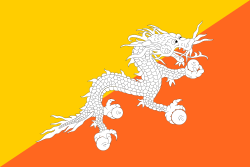National flag
| Flag | Date | Use | Description |
|---|---|---|---|
 | 1969-Present | Flag of Bhutan | Divided diagonally from the lower hoist-side corner to the upper fly-side corner; the upper triangle is yellow and the lower triangle is orange, with a white dragon holding four jewels in its claws centered along the dividing line and facing away from the hoist. [1] [2] |
 | 1969-Present | Flag of Bhutan (vertical) | |
 | 1969-Present | Flag of Bhutan (variant) |












